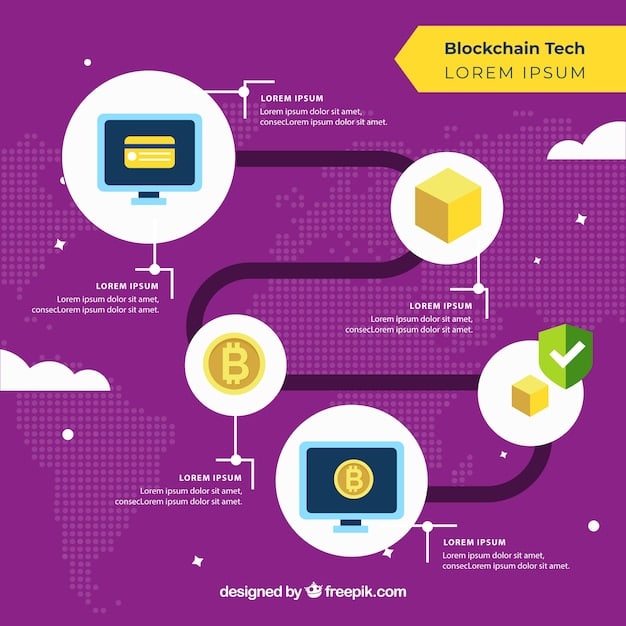DeFi in the US: Investing in Decentralized Finance in 2025

The Future of DeFi in the US: Investing in Decentralized Finance in 2025 involves navigating regulatory landscapes, technological advancements, and evolving investor sentiment to harness opportunities in decentralized lending, trading, and asset management within the American market.
The Future of DeFi in the US: Investing in Decentralized Finance in 2025 presents both challenges and opportunities for investors. Understanding these dynamics is essential for navigating this rapidly evolving landscape.
Understanding Decentralized Finance (DeFi)
Decentralized Finance, or DeFi, has emerged as a transformative force within the financial industry. It aims to recreate traditional financial systems in a decentralized and transparent manner. Here’s a closer look at what DeFi entails.
What is DeFi?
DeFi refers to financial applications built on blockchain technology, primarily using smart contracts. These applications aim to provide services like lending, borrowing, trading, and investment management without the need for traditional intermediaries.
The core principle of DeFi is to democratize finance by removing central authorities. This allows for greater accessibility, efficiency, and innovation in financial services.
Key Components of DeFi
DeFi encompasses various components that collectively work together to create a decentralized financial ecosystem. These components include decentralized exchanges (DEXs), lending platforms, stablecoins, and yield farming protocols.
- Decentralized Exchanges (DEXs): Platforms where users can trade cryptocurrencies directly with each other, without a central intermediary.
- Lending Platforms: Protocols that allow users to lend and borrow cryptocurrencies, earning interest on their deposits or paying interest on their loans.
- Stablecoins: Cryptocurrencies pegged to a stable asset like the US dollar, providing stability and reducing volatility within the DeFi ecosystem.
- Yield Farming Protocols: Platforms that incentivize users to provide liquidity to DeFi protocols in exchange for rewards in the form of additional tokens.

DeFi’s growth is driven by the promise of financial inclusion, transparency, and efficiency. However, it also presents risks related to smart contract vulnerabilities, regulatory uncertainty, and market volatility. As the DeFi landscape continues to evolve, understanding these components is crucial for anyone looking to participate in or invest in this innovative financial space.
The Current State of DeFi in the US
The DeFi sector in the US is rapidly evolving, marked by increasing adoption, regulatory scrutiny, and innovative developments. Understanding the current landscape is crucial for investors looking to navigate this space.
Adoption and Growth
DeFi adoption in the US has seen substantial growth, driven by increasing awareness of its potential benefits. More users are exploring DeFi platforms for lending, borrowing, and trading cryptocurrencies.
The total value locked (TVL) in DeFi protocols provides a quantitative measure of this growth. TVL represents the total amount of assets deposited in DeFi applications, indicating the level of participation and confidence in the ecosystem.
Regulatory Landscape
The regulatory landscape for DeFi in the US is still developing and remains a significant factor shaping its future. Government agencies like the Securities and Exchange Commission (SEC) and the Commodity Futures Trading Commission (CFTC) are actively evaluating DeFi protocols to determine how existing regulations apply.
Regulatory uncertainty poses both challenges and opportunities for the DeFi sector. Clarity in regulations could foster greater institutional participation and innovation, while overly restrictive regulations could stifle growth.
Key DeFi Projects and Platforms in the US
Several notable DeFi projects and platforms have emerged in the US, contributing to the growth and innovation of the sector. These projects span various DeFi applications, including lending, borrowing, and decentralized exchanges.
- MakerDAO: A decentralized credit platform that enables the creation of DAI, a stablecoin pegged to the US dollar.
- Compound: An algorithmic interest rate protocol that allows users to earn interest on their cryptocurrency holdings.
- Uniswap: A decentralized exchange protocol that facilitates automated trading of cryptocurrencies.
The current state of DeFi in the US is characterized by rapid growth, regulatory uncertainty, and innovative projects. Investors must stay informed about these developments to make informed decisions and navigate the evolving DeFi landscape.
Factors Shaping the Future of DeFi in 2025
Several factors are poised to significantly influence the future of DeFi in the US by 2025. These include technological advancements, regulatory developments, market trends, and adoption rates.
Technological Advancements
Technological advancements are a primary driver of innovation in the DeFi sector. Key technologies like Layer-2 scaling solutions, cross-chain interoperability, and improved smart contract security are expected to play a crucial role in shaping the future of DeFi.
Layer-2 scaling solutions aim to improve the scalability and efficiency of blockchain networks, enabling faster and cheaper transactions. Cross-chain interoperability allows different blockchain networks to communicate and interact with each other, fostering greater liquidity and collaboration within the DeFi ecosystem.
Regulatory Environment
The regulatory environment will significantly impact the growth and adoption of DeFi in the US. Clear and balanced regulations can provide a framework for innovation while protecting investors and ensuring market integrity.

Regulatory clarity is essential for fostering institutional participation and mainstream adoption of DeFi. Uncertainty can lead to hesitancy and slow down the growth of the sector.
Market Trends and Adoption Rates
Market trends and adoption rates will also play a crucial role in shaping the future of DeFi. Increasing awareness and understanding of DeFi, coupled with growing institutional interest, could drive further adoption.
The emergence of new DeFi use cases and applications can attract a broader audience and stimulate innovation. Additionally, partnerships and collaborations between DeFi projects and traditional financial institutions could accelerate adoption rates.
The future of DeFi in the US will be shaped by a combination of technological advancements, regulatory developments, market trends, and adoption rates. Investors must closely monitor these factors to identify opportunities and manage risks in the evolving DeFi landscape.
Potential Opportunities in DeFi Investing in 2025
Investing in DeFi presents several potential opportunities for investors looking to capitalize on the growth and innovation of this sector. These opportunities span various DeFi applications and protocols.
Yield Farming and Liquidity Providing
Yield farming involves providing liquidity to DeFi protocols in exchange for rewards in the form of additional tokens. Liquidity providers earn transaction fees and token rewards for contributing to the liquidity of decentralized exchanges and lending platforms.
Yield farming can generate attractive returns for investors, but it also carries risks such as impermanent loss and smart contract vulnerabilities.
Decentralized Lending and Borrowing
Decentralized lending and borrowing platforms allow users to lend and borrow cryptocurrencies without the need for traditional intermediaries. Lenders earn interest on their deposits, while borrowers pay interest on their loans.
These platforms offer greater accessibility and transparency compared to traditional lending and borrowing services.
Investing in DeFi Tokens
Investing in DeFi tokens is another way to participate in the growth of the DeFi sector. DeFi tokens represent ownership or governance rights in DeFi protocols and platforms.
- Governance Tokens: Allow holders to vote on proposals and influence the direction of the protocol.
- Utility Tokens: Provide access to specific features or services within the DeFi ecosystem.
Investing in DeFi tokens carries risks related to market volatility, regulatory uncertainty, and project-specific risks. Conduct thorough research and due diligence before investing in DeFi tokens.
DeFi investing offers several potential opportunities for investors. However, it’s crucial to understand the risks involved and conduct thorough research before allocating capital to DeFi projects and protocols.
Navigating Risks and Challenges
Investing in DeFi comes with its own set of risks and challenges. These include regulatory uncertainty, security vulnerabilities, and smart contract risks and understanding these factors is critical for investors.
Regulatory Uncertainty
Regulatory uncertainty remains a significant challenge for the DeFi sector. The lack of clear regulations can create uncertainty and hinder institutional investment.
Investors need to stay informed about regulatory developments and understand how they may impact their investments.
Security Vulnerabilities
DeFi protocols are susceptible to security vulnerabilities, such as hacks and exploits. Smart contract vulnerabilities can result in the loss of funds for users and investors.
Investors should assess the security practices of DeFi projects and choose platforms with robust security measures.
Smart Contract Risks
Smart contracts are the foundation of DeFi applications, but they are not immune to errors. Bugs or vulnerabilities in smart contracts can lead to unintended consequences and the loss of funds.
- Code Audits: Independent audits of smart contract code can help identify and mitigate potential vulnerabilities.
- Insurance Protocols: DeFi insurance protocols can provide coverage against smart contract failures and other risks.
Navigating the risks and challenges of DeFi investing requires careful due diligence, risk management, and staying informed about regulatory and technological developments. By understanding and mitigating these risks, investors can participate in the growth of the DeFi sector while protecting their capital.
Strategies for Investing in DeFi in 2025
Developing effective strategies for investing in DeFi is essential for maximizing returns and managing risks. These strategies involve conducting thorough research, diversifying investments, and staying informed about market trends.
Conduct Thorough Research
Conduct thorough research before investing in any DeFi project or protocol. Understand the underlying technology, team, and business model.
Assess the security practices, regulatory compliance, and market potential of the project.
Diversify Investments
Diversify your investments across different DeFi applications and protocols. Avoid concentrating your capital in a single project or platform.
Diversification can reduce the impact of project-specific risks on your overall portfolio.
Stay Informed About Market Trends
Stay informed about market trends, regulatory developments, and technological advancements in the DeFi sector. Follow industry news, attend conferences, and engage with the DeFi community.
Staying informed can help you identify emerging opportunities and anticipate potential risks.
Effective strategies for investing in DeFi involve conducting thorough research, diversifying investments, and staying informed about market trends. By following these strategies, investors can optimize their returns and manage risks in the evolving DeFi landscape.
| Key Point | Brief Description |
|---|---|
| 🚀 DeFi Growth | Increasing adoption and TVL in DeFi protocols drive sector growth. |
| ⚖️ Regulatory Impact | Regulatory clarity is essential for fostering institutional participation. |
| 🔒 Security Risks | Smart contract vulnerabilities pose risks to DeFi investments. |
| 🌱 Diversification | Diversifying investments across DeFi reduces project-specific risks. |
FAQ
▼
DeFi, or Decentralized Finance, uses blockchain for financial services like lending and trading. It cutouts intermediaries using smart contracts, creating a transparent system.
▼
DeFi investing offers high returns, greater control over assets, and transparency. Anyone with Internet access can participate, fostering a more accessible financial system.
▼
DeFi investments involve smart contract vulnerabilities, regulatory uncertainty, and market volatility. Rug pulls and impermanent loss are also potential concerns for investors.
▼
Mitigate DeFi risks by diversifying investments and researching thoroughly. Using platforms with security audits and keeping up with evolving regulations can help minimize risks.
▼
The future for DeFi in the US depends on regulations, technology advancements, and market adoption. Despite present obstacles, DeFi is positioned for growth and mainstream acceptance in finance.
Conclusion
As we look towards 2025, the Future of DeFi in the US: Investing in Decentralized Finance in 2025 offers intriguing possibilities and obstacles. Grasping the technological advancements, regulatory environment, and risk management strategies will be essential. With careful planning and constant learning, you can navigate this exciting new world and tap into the lucrative opportunities it presents.





